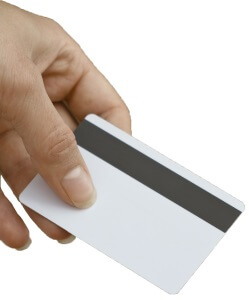
How a Magnetic Stripe can enhance your Photo ID Cards
Everyone is familiar with the “magstripe” card, because that is the technology you’re using when you “swipe” your debit or credit card at the cash register to make a purchase. Cards with a magnetic stripe on the back were invented by IBM in 1969, and have been in common use since the 1980’s.
The magstripe is made up of tiny iron-based magnetic particles in a plastic-like film. Each particle is really a very tiny bar magnet about 20 millionths of an inch long. The magstripe can be “written” because the tiny bar magnets can be magnetized in either a north or south pole direction. The magstripe on the back of the card is very similar to a piece of cassette tape fastened to the back of a card.
A standard magnetic stripe card has 3 tracks available, referred to as Track 1, Track 2, and Track 3. The use of these tracks is set out in a standard called ISO7813, which defines where on the stripe this information appears, what characters are permitted, how many characters are allowed, and so forth.
There are two categories of magstripe cards, commonly referred to as “Lo-Co” and “Hi-Co”.
- Lo-Co is short for Low Coercivity, is rated at 300 Oe. Lo-Co cards require less power to encode and erase, and are often used for hotel door locks where cards need to be reprogrammed on a regular basis.
- Hi-Co is short for High Coercivity, and these can either be rated at 2750 Oe or 4000 Oe. The higher value means the cards are much more difficult to accidentally erase, and used where data needs to be held unchanged for a long period of time, such as on bank cards.
Each magnetic stripe is encoded in the following way:
Start Character + Data + End Character + Check Value
- The start character lets the reader know that the data is about to begin. This character is different for each track.
- The data can then be empty, or up to the maximum length permitted for that track.
- The end character comes after all of the data, to let the reader know that no more data is present.
- Finally there is a check value, which is a character that is generated based upon an algorithm of the data used. This allows the reader to check that it has read everything properly.
What information can be programmed?
- On Track 1 there can be up to 76 characters of data, using the characters 0-9 A-Z $^()-./ (Alphanumeric)
- On Track 2 there can be up to 37 characters of data, using the characters 0-9 = (Numeric)
- On Track 3 there can be up to 104 characters of data, using the characters 0-9 = (Numeric)
Most cards are manufactured with the full sized 12mm magnetic stripe that can hold all 3 tracks of information. However, the card may be only programmed with just 1 or 2 tracks of information.
How easy is it to read the data?
Magnetic stripe information can be easily read with a magnetic stripe reader. Readers are readily available that connect to the USB port of a computer. When the card is swiped the computer will read it as if someone had typed the information on the keyboard.
Can you tell how my cards are programmed?
Many clients have an existing system to read cards. If you send us a few of your existing cards, we can easily analyze them to determine their exact encoding scheme.
